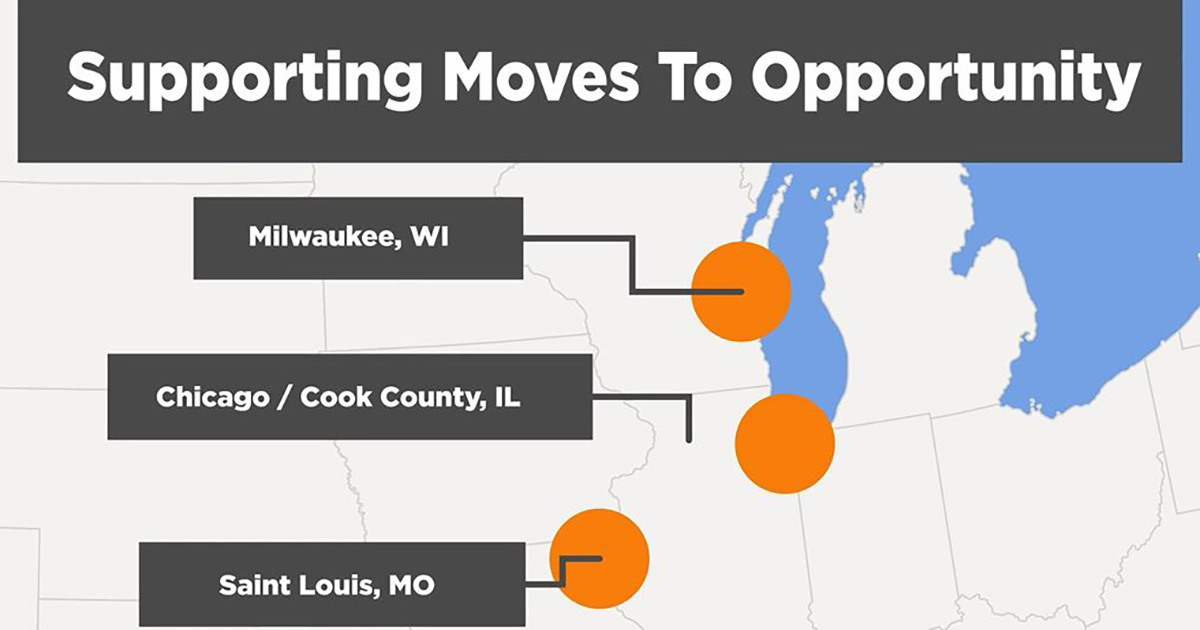Supporting Moves to Opportunity

Overview
Growing up in high-poverty, highly segregated neighborhoods can limit the future prospects of young children. But low-income families with children often lack sufficient resources and face other systemic barriers to choosing freely what neighborhoods they live in. The federal government’s Housing Choice Voucher Program, which subsidizes rent for some low-income families, helps only a small fraction of families with children to use vouchers to live in low-poverty areas. Encouraging findings from recent studies conducted by Harvard University researchers suggest that young kids who move to certain types of neighborhoods, called high-opportunity neighborhoods, are likely to earn more money as adults and are more likely to attend college, compared with their peers who live outside of high-opportunity neighborhoods. How can the Housing Choice Voucher program help more families move to, remain in, and thrive in high-opportunity neighborhoods and increase their chances of economic success?
As part of Creating Moves to Opportunity (CMTO), researchers at Harvard’s Opportunity Insights—in partnership with MDRC and other researchers—are testing whether delivering services to families in the voucher program in Seattle and King County, Washington, can help foster moves to high-opportunity areas. Early positive results from CMTO have sparked interest in testing new mobility initiatives that lead to larger and more sustained moves to high-opportunity areas in other contexts around the country, particularly those with historically high patterns of racial segregation in housing markets.
MDRC, as part of the Supporting Moves to Opportunity (SMTO) demonstration, is spearheading a next generation of mobility initiatives. In partnership with public housing agencies and service providers in three regions (Chicago-Cook County, IL; Milwaukee, WI; and St, Louis, MO), SMTO will build on earlier efforts and test the effects of initiatives that offer services and supports either before or after families move—developing evidence that will inform federal efforts to expand housing choice policy.
The St. Louis and Milwaukee programs began enrolling families in 2020. Enrollment is slated to begin in Chicago-Cook County in early 2021.
Additional Project Details
Agenda, Scope, and Goals
SMTO aims to build evidence about the effectiveness of housing mobility strategies for households receiving Housing Choice Vouchers from the U.S. Department of Housing and Urban Development. It will do so by rigorously testing different interventions designed to promote housing and economic mobility.
- Opportunity MKE, the program in Milwaukee, and Mobility Connection, the program in St. Louis, assist families as they prepare to move with their housing searches, applications, and security deposits. These programs share the common goal of enabling families with housing vouchers to move to lower-poverty communities that may improve their opportunities for upward economic mobility and better life outcomes. Once families move, program staff members check on families regularly to see if they need help finding new child care, enrolling their children in school or extracurricular activities, getting referrals to employment services or learning new commuting routes to work, and dealing with landlords and housing issues.
- The 2Gen program in Chicago-Cook County supports families after they move. A core underlying hypothesis is that persistence in high-opportunity neighborhoods can be influenced through assistance not only with landlord-related challenges and planning for subsequent moves, but also through assistance with other issues that might affect families’ desire or ability to remain in such communities. Thus, family coaching will address the educational, employment, emotional, and social needs of children and parents, while helping them build networks in their new communities. Staff members will work with parents and older adolescents to help them identify career paths, set goals and action steps, develop job-search skills, explore education and training opportunities, and address challenges to employment and advancement.
Randomized controlled trials will test the effectiveness of the different program models. In St. Louis and Milwaukee, the evaluation will assess whether program services help more families move to and stay in high-opportunity neighborhoods. For the Chicago-Cook County site, which includes a more comprehensive research agenda, the evaluation team will also assess whether program services increase parents’ employment and earnings, improve children’s school performance, and improves overall household social, emotional, and financial well-being.
Design, Sites, and Data Sources
The evaluation includes implementation and impact analyses. The implementation analysis will document how the programs operate on the ground, how program staff address operational challenges, the types of services participants receive, and the experiences and responses of families and landlords. To assess program impacts, the evaluation will rely on random assignment research designs. The impact analysis will draw on agency administrative records data and assess the extent to which the models improve participants’ outcomes, including moves to high-opportunity areas, continued residence in these neighborhoods, and employment and earnings outcomes. Supplemental data collection efforts, such as follow-up surveys, will be conducted for the Chicago-Cook Country 2Gen program, which includes a more comprehensive evaluation plan.







